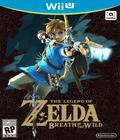Pre-order The Legend of Zelda: Breath of the Wild
While the Mario games are Nintendo's best sellers, nothing is quite as big an event as a new Zelda title. Nintendo's entire booth at E3 2016 was dedicated to the The Legend of Zelda: Breath of the Wild, and despite that, the line was still out the door. Fortunately, we got some time to see the game in action, and what we saw looks very impressive.
Breath of the Wild opens in a mysterious way. Link awakens in a strange shrine, seemingly having been in some kind of stasis or hibernation. He pulls on some clothes and stumbles out into what appears to be Hyrule. It's a Hyrule that can be described as postapocalyptic, filled with empty space and dilapidated buildings. The only signs of life are a mysterious woman's voice who urges him forward and a strange old man. Apparently a terrible beast took over Hyrule and was locked away but will soon escape from his imprisonment. This Calamity Ganon threatens the entire world unless Link can find a way to stop him.
From what we saw during our brief gameplay demonstration, a number of the Zelda traditions have been broken. Hearts are no longer found just by smashing pots and cutting grass. Instead, you have to actually collect food from the environment. This food recovers health based on how it has been cooked and prepared. A well-baked piece of meat is a lot more filling (and thus healing) than a lone apple. Hyrule's postapocalyptic environment also means that money doesn't appear to be a thing. I didn't see an example of rupees despite taking a close look. Perhaps that comes into play later in the game, but early on, you're going to be more worried about cooking and crafting rather than buying.
Another unusual break from the mold is Link's traditional green tunic and sword. Despite being about as much a part of the character as Mario's overalls and red hat, they're nowhere to be seen in Breath of the Wild. Instead, Link has equippable armor and weapons that must be scavenged from the environment. While the Master Sword appears in the game trailer, don't expect to see it early on. Instead, you'll find old rusted broadswords, woodcutter axes and heavy sticks that can be used as weapons. They're not the most durable things out there, so you'll have to keep finding new weapons to use, up to and including stealing them from enemies. The good news is that it if your weapon breaks, there's always one nearby. (Attacking an enemy with a breaking weapon actually seems to make them drop their own, though that could have been coincidence.) It's an unusual break for a franchise that until recently could have been defined as "a boy with a green tunic and a sword."
The other major change that we saw is the game's sense of freedom. Zelda has always been a sort of guided experience. Even the most open games were careful to give you plenty of guidance. Breath of the Wild appears more similar to something like Far Cry. Link is tossed into a big, open world and told, "Go see what you can find." While there are undoubtedly dungeons and items in the game, some of the expected comforts may not be there. For example, the first bow you find is in a random chest and is treated as something genuinely unexceptional rather than your first big dungeon item. There also doesn't seem to be a helper character like Navi or Fi. Instead, you have a Shiekah Slate, which is a combination of key and binoculars, allowing you to activate certain objects and pointing you toward shrines that house potential power-ups. For example, one of these is a stasis power that lets you freeze objects in place. Frozen objects retain any kinetic energy applied to them, which can be used to solve puzzles.
There are a lot of small things we noticed that are still rather mysterious. For example, it seems like temperature will play a part in the game, with a gauge on the HUD seeming to warn Link of extreme heat and cold. This isn't anything new; previously, items like the Goron Tunic were necessary to avoid terrible death inside an active volcano. However, with the new gear system, it seems like you'll have to keep things in mind and balance defense and proper protection. Combat also seems to have some new quirks. While it plays very similarly to games like Wind Waker and Twilight Princess, there are a few twists, such as a Bayonetta-style slowdown when you narrowly dodge an attack and a shield bash.
All in all, what we saw of The Legend of Zelda: Breath of the Wild is extremely impressive. The game looks beautiful and feels familiar and brand new at the same time. There are enough of the classic Zelda elements that you won't mistake it for anything else, but every bit of the traditional Zelda gameplay has been tweaked in some fashion. What was once familiar is strange and new, and it's a surprisingly ambitious change to the franchise. More details will certainly be revealed before Breath of the Wild's release in early 2017 for the Nintendo Wii U and the upcoming Nintendo NX.
More articles about The Legend of Zelda: Breath of the Wild











 The Legend of Zelda returns to the series' roots and features an open-world design.
The Legend of Zelda returns to the series' roots and features an open-world design.














